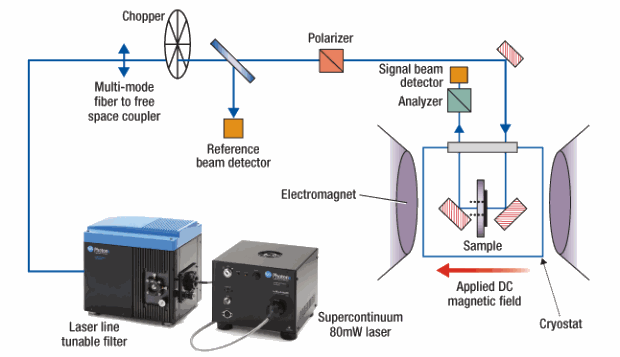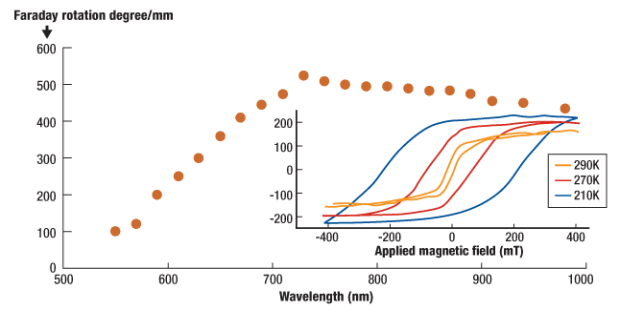Gabriel Monette, Université de Montréal, Montreal, Canada and Marc Verhaegen, Photon etc., Montreal, Canada
Magneto-optical (MO) effects are used as tools for probing the magnetization reversal characteristics of a wide range of sample types, and as an effective way to modify the polarization of light via induced magnetization state in samples. In transparent samples, the Faraday effect (rotation of the polarization of light proportional to the magnetic induction field and optical path in the medium) can be used to elaborate Faraday rotators, a key element in the design of optical isolators [1]. Along with other MO effects such as Kerr measurements, they provide a non-destructive probe for in-situ measurements of samples, such as thin films.
Spectral dependence of the Faraday MO effect in the visible part of the electromagnetic spectrum along with temperature dependence measurements were performed on a semiconductor 2micron epilayer (GaP) grown with embedded metallic ferromagnetic nanoclusters (MnP). The confined geometry of the experiment — which necessitates a cryostat chamber with optical window placed within the pole gap of an electromagnet applying the DC magnetic field parallel to the normal of the sample — made it difficult to use a monochromatic light beam produced by filtering an incandescent light source with a standard monochromator.
 |
|
Figure 1. Experimental set up. |
Instead, the team used a collimated tunable laser based on a Leukos (SP20) supercontinuum source and Photon etc’s Tunable Laser Line Filter. Figure 1 shows the experimental set up used to investigate the MO properties of the GaP:MnP in the Faraday configuration. The analyzer is mounted on a motorized rotation stage to allow tracking of the extinction condition as a function of temperature, wavelength and applied magnetic field. Hysteresis curves were obtained by rotating the analyzer at 45° with respect to the polarizer and sweeping the magnetic field from -400 to 400 mT. Small angles of rotation ensure linear variation in transmitted intensity as a function of the rotation angle of the polarization, or applied magnetic field. The source of the electromagnet, the temperature controller for the cryostat, the angular position of the analyzer, and the wavelength selection of the laser output (via Photon etc Tunable Laser Line Filter) are all computer controlled. The angle of rotation must be obtained independently for each applied field, wavelength, and temperature.
 |
| Figure 2. Faraday rotation vs wavelength. |
The total Faraday rotation of the epilayer as a function of wavelength at a temperature of 220K is displayed in figure 2. The free carriers contribution of the GaP substrate has been carefully substracted. The GaP:MnP epilayer produces a maximum MO effect in the near infrared, whereas the substrate has a monotonic decrease in the MO effect as the wavelength is increased. The inset shows the Faraday rotation hysteresis curves at 210K, 270K and 290K at 655nm. The giant Faraday rotation in these systems has been reported [2]. The tunable laser allowed us to investigate the hysteresis signature of the MO Faraday effect at different wavelengths as well as different temperatures within the limited work space of the apparatus.
Future applications
Although this specific experiment and material (GaP:MnP) aim at a better understanding of the underlying physics of effective medium, i.e. the interaction between EM-waves and metamaterials made of metallic nanoclusters embedded in a semiconductor host matrix, it can be applied to develop new, easily integrated opto-isolators. Magneto-optical effects in general can be used for a wide range of applications, from data storage and processing to thin films characterizations or even remote magnetic field sensors. The Faraday effect in particular is of paramount importance in modern optical networks for it is the very corner stone for devices such as isolators and circulators.
REFERENCES
[1] T. R. Zaman, X. Guo and R. J. Ram, Semiconductor Waveguide Isolators, Journal of Lightwave Technology, 26, 2, (2008)
[2] G. Monette, C. Lacroix, S. Lambert-Milot, V. Boucher, D. Ménard and S. Francoeur, Giant magneto-optical Faraday effect in GaP epilayers containing MnP magnetic nanoclusters, Journal of Applied Physics, 107, 9, (2010)
Marc Verhaegen, PhD, 5795 Gaspé av., #222, Montreal, H2S2X3, QC, Canada; ph.: 514-385-9555; [email protected]

